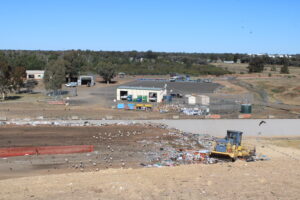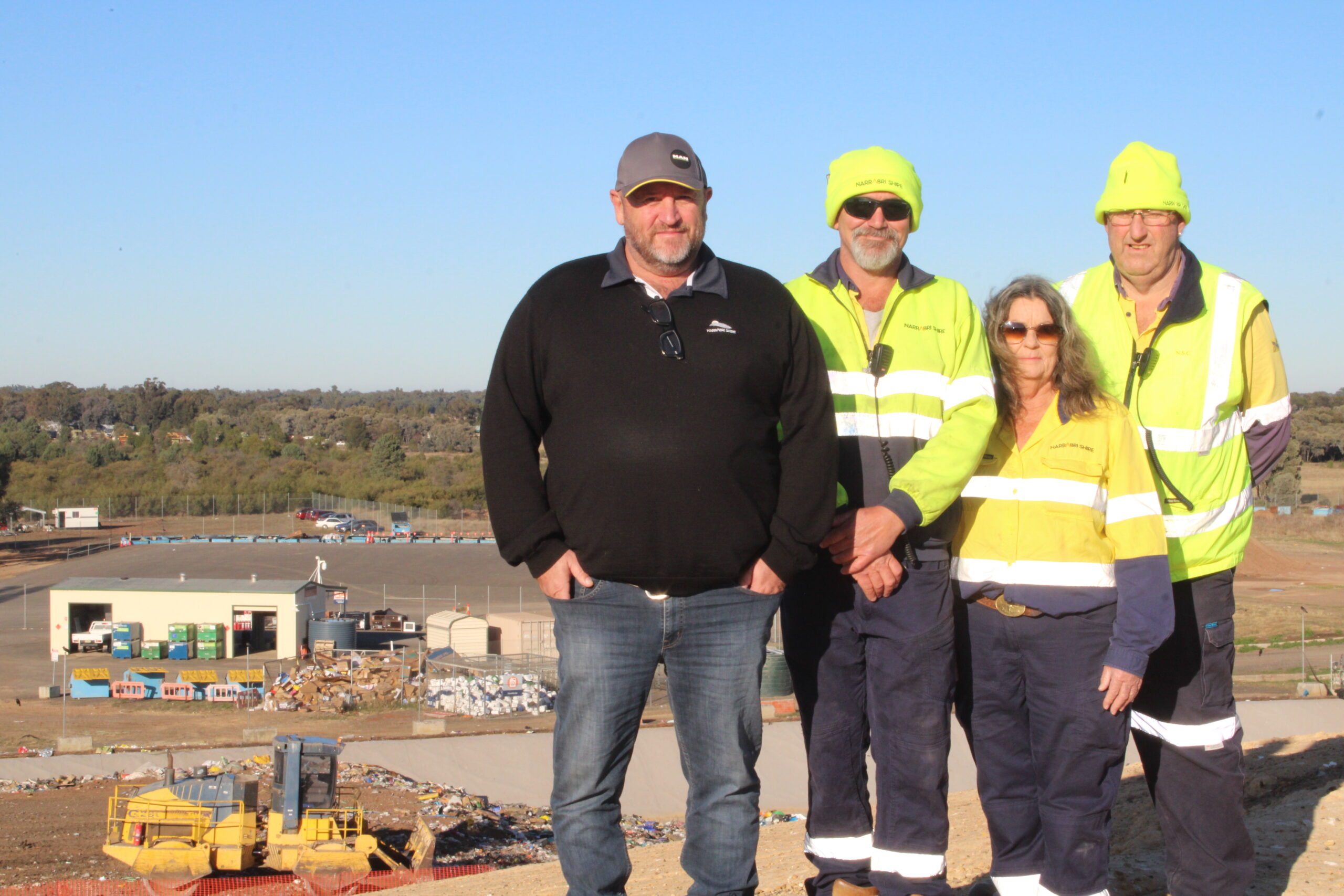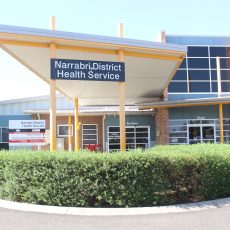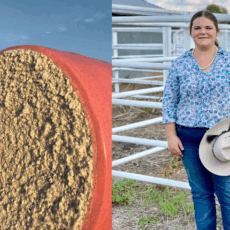The view from the Narrabri Waste Management Facility is looking tip-top, a far cry from the tip of some years ago.
In its original 1980s Culgoora Road location east of the present site, the tip was a wasteland of every kind of rubbish, lumped in together often with a smoke haze hanging overhead.
The wind took anything which would blow beyond its defined boundaries and was a perennial subject of complaint in those years.
Fires would occasionally be burning away quietly at various places sending an often-noxious plume of smoke downwind.
It was not uncommon for some dumpers to put a match to their own freshly delivered rubbish, and sometimes tip-goers would leave carrying more than they had arrived with, ‘scavenging’ was the unseemly term for it.
Today Narrabri Shire manager of waste services Michael Davis says, “Once upon a time it was just applying waste to land but that changed in the early 2000s, we’ve come a very long way in our waste management progress.”
“Ten to 15 years ago, the Narrabri landfill was behind the curve, but with commitment from council, management, and staff to provide funding and infrastructure, the waste management team is as ahead of the curve as they can be.
“In 2011 we thought we were receiving 5600 tonnes of rubbish into the landfill every year, but through more surveying, we found the reality was more like double.
“But that was then, now we’re doing even more – last year it was recorded that the staff out at the landfill deal with 60 tonnes of waste coming into the landfill per day as well as the waste from transfer stations across the shire.”
About 1150 vehicles on average visit the tip from across the shire every week, with 800 plus visitors from Narrabri, 180 from Wee Waa, 85 From Boggabri, 35 from Bellata, and others from surrounding areas like Edgeroi, Baan Baa, Maules Creek, Pilliga and Gwabegar.
When you get to the tip, located on the aptly named Dump Road, you’ll be greeted by cheerful bouquets of newly planted geraniums and artful garden arrangements all sourced from disposed items and green waste.
You will be met by an attendant on your way across the weighbridge, who’ll say g’day and ask what you’ve got onboard today; whether it’s general waste, recycling, tires, mattresses, or scrap metal.
Then you’re off on a journey through what looks more like a parkland than a rubbish dump, and that’s where the adventure begins.
Maybe you’ll head to the community recycling centre to drop off light bulbs, gas cylinders, batteries, chemicals, paints, e-waste, fire extinguishers, and all that type of stuff which was funded by the Environmental Protection Association (EPA) through a grant.
Maybe you’ll visit the oil shed to responsibly dispose of domestic-related motor oil volumes or drum musters which are all collected by local drum muster man Phil Tucker.
Or there’s the newly implemented cardboard cage beside the co-mingling and recycling station all of which gets collected and picked up by contractor Challenge Recycling.
And let’s not forget the impressive stockpiles of green waste, mattress stacks, and rolling tyre-hillside.
When general waste comes into the landfill from other transfer stations or tip-goers’ drop-offs, it goes to a cell, where it is maintained by being pushed down and compacted, to help get rid of air and covered with soil to make sure trash doesn’t fly everywhere.
“Soil that is used to cover the daily waste must be constituted of an ENM material at a minimum and costs approximately $120,000 a year but because we’ve had lots of roadworks, 20,000 tonnes of material was dropped off which got us three years’ worth of material and a huge saving of $300,000 to $400,000 to the budget for the next few years,” said Mr Davis.
If this compaction service isn’t done, along with efforts to reduce waste going into the cell, it would be filled up in six months.
The Narrabri waste management team has been so effective in their efforts that they now manage to deviate 50 per cent of waste away from general landfill through recycling and stockpiles.
“The struggle is making sure that happens every day because as you can imagine with 60 tonnes, you’ve got to break that down into smaller chunks, just like anything,” said Mr Davis.
“With waste management, if we aren’t constantly rolling over and taking the air out of the waste it becomes too large and when we don’t get the compaction rates to take the air out, we fill up the cell quicker.
“The greatest challenge is not chasing waste, there must be good systems in place to remain ahead of the curve all the time, because once you fall behind and there’s rain and floods then you’re in trouble and it’s hard to catch up.
“Before, when waste was dumped, we would get to it days later because we were so busy with everything but now the waste turns up and it gets dealt with. We used to work reactively, now we work proactively.”

The method of waste management has improved drastically over the years.
Then the waste management site constructed the first lined cell in 2005, it filled up faster than anticipated, but because of undercharging for waste services there was no money for a new one.
As the cell rubbish started raising above ground, it raised interest from the EPA, and the facility was forced to implement $2 gate fees at the time, which turned into a resulting waste levy to collect funds.
“Council spent the money on the rehabilitation cost, and we looked at how we would continue to fill the above-ground cell and construct another above-ground cell, which is what we have here today,” said Mr Davis.
The original above-ground cell is the current landmark of the dump standing at 20 feet high and holds 15 to 20 years of Narrabri’s trash.
If you ever make it to the top of the impressive, lined cell, it’s more akin to standing on a mountain, than 15 years of Narrabri’s trash, and the surrounding views are breathtaking – no dump puns intended.
“The current above ground general waste cell started as a below ground lined cell, only lasting five years,” said Mr Davis.
“When we go back to mined cells, we will try to construct a cell which will be seven meters deep but have a lifespan of 10 years.”
The new above ground cell which became operational this year uses different layers to capture landfill gas and leachate liquid created from putrescible waste when it breaks down.
“This is the standard required by the EPA. This cell has a life span of approximately 3.5 years and costs double of the original cell of 2005,” said Mr Davis.
“We only started filling the cell this year and it’s already quite full, since people are also disposing of higher volumes of waste, it will only last another three to four years.”
The facility employs 10 staff over a fortnightly roster to manage the huge 60-tonne waste load and man the transfer stations, with three staff on daily duties, a team leader, and a coordinator.
“It’s almost a conveyor-belt-like service, and when things go wrong like site breakdowns, staff off sick or heavy rain, that’s when things start to pile up,” said Mr Davis.
“It wouldn’t be as efficient without the community working together to dispose of rubbish correctly, their help is a crucial component.
“Putting rubbish where it’s meant to go, and not illegally dumping is a big help because that time it takes to deal with contamination really slows us down from doing the right things, and that’s also when the cost goes up.”
The tight-knit team tackle the seemingly insurmountable task while maintain the seamlessly run facility, with some of its members being on the team for more than 12 years.
“Narrabri is extremely lucky, the staff we’ve got out here are not only good people, but they’ve done a great job, they are all engaged and committed and that’s all you can ever expect from people, everyone has great work ethic,” said Mr Davis.
“John, our waste coordinator, has been out here five years and brought excellent skills to the council. He is a competent, professional dude and he manages the team and operations out here well.
“The roster helps as these guys are all dedicated fishermen, except Maree who has been out here 12 years and doesn’t fish, but they maintain this place perfectly.
“When you’ve got a good team and get good results it shows and engages the community.
And there’s plenty more that the team wants to provide for the community, with plans for a proper buyback centre, a community garden made from processing the green waste and more beautiful garden arrangements.
“We can turn the food scraps and leafy stuff into organic material, or we mulch the timber stuff so there’s a mulch that we can provide back to the community, at a small fee,” said Mr Davis.
“So instead of putting it into the land we’ll be using it and keep it in that circular economy process and the same area will be a buyback centre.
One thing is for sure, the Narrabri Waste Management facility is one of the cleanest in the land, and the EPA would even agree, that it’s transfer stations are of a regional, national standard.
“I’ve been all around Australia at waste conferences and worked with many communities, and Narrabri has got one of the cleanest landfill sites that I have seen,” said Mr Davis.
“You can see how clean it is, it almost looks like parkland, which is what we want to achieve.
“We are passionate about what we do, and we to do this to provide the best outcome for our environment and our future shire residents.”
To order photos from this page click here










